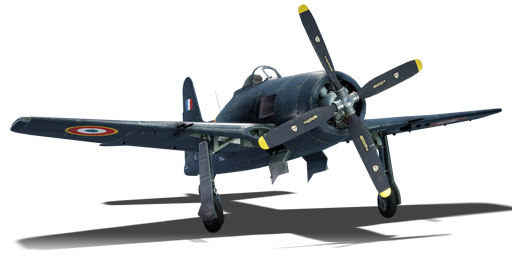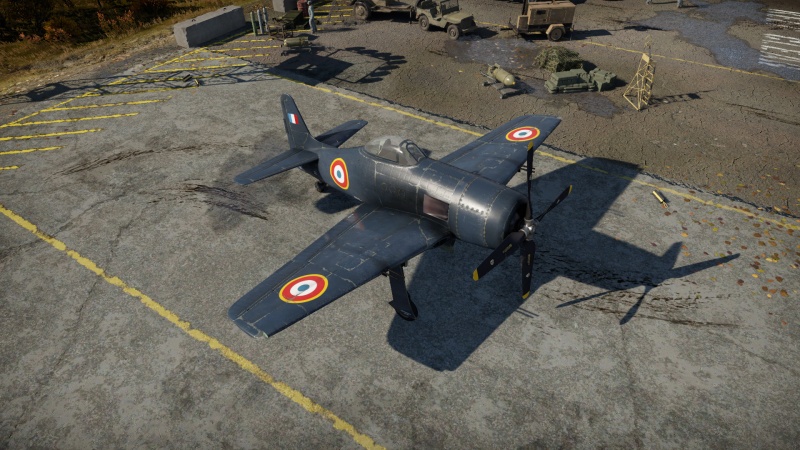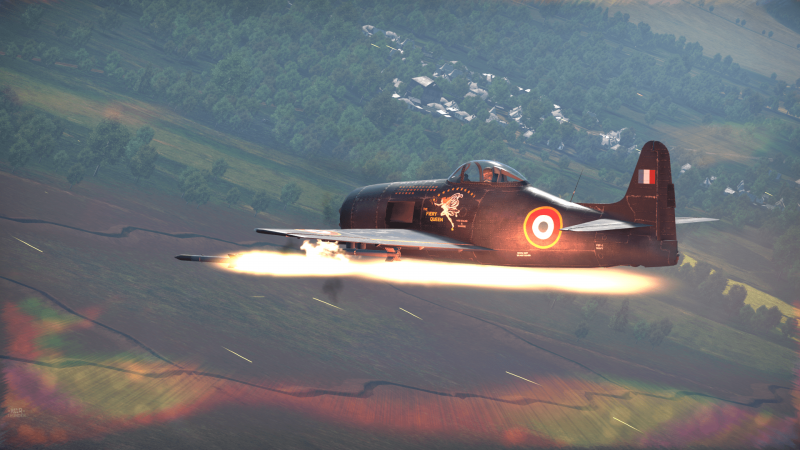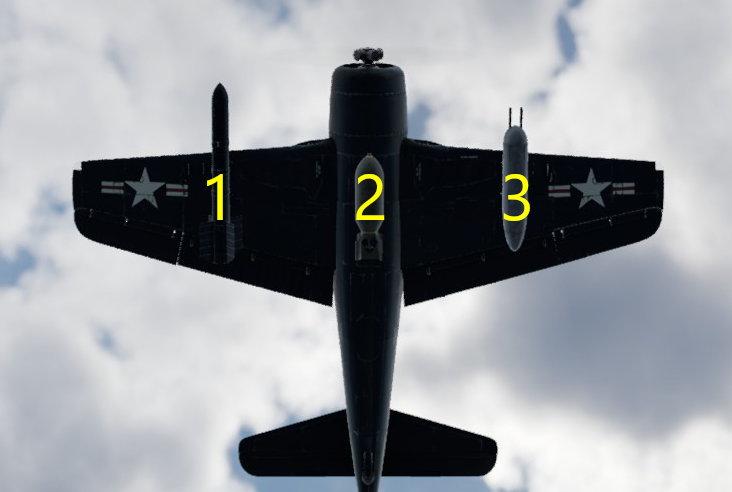Difference between revisions of "F8F-1B (France)"
(→Description: updated) (Tag: Visual edit) |
(→Description) |
||
| Line 13: | Line 13: | ||
== Description == | == Description == | ||
<!-- ''In the description, the first part should be about the history of and the creation and combat usage of the aircraft, as well as its key features. In the second part, tell the reader about the aircraft in the game. Insert a screenshot of the vehicle, so that if the novice player does not remember the vehicle by name, he will immediately understand what kind of vehicle the article is talking about.'' --> | <!-- ''In the description, the first part should be about the history of and the creation and combat usage of the aircraft, as well as its key features. In the second part, tell the reader about the aircraft in the game. Insert a screenshot of the vehicle, so that if the novice player does not remember the vehicle by name, he will immediately understand what kind of vehicle the article is talking about.'' --> | ||
| − | Shortly after WWII, France was in dire need of relatively modern military equipment, since conflicts in their colonies started to become more and more violent. Many allied nations like the US and Great Britain supplied France with | + | Shortly after WWII, France was in dire need of relatively modern military equipment, since conflicts in their colonies started to become more and more violent. Many allied nations like the US and Great Britain supplied France with surplus military vehicles left after WWII, like M4 Shermans, Spitfires, and other vehicles. The '''F8F-1B Bearcat''' was one of these aircraft, designed with the lessons learned during the Battle of Midway, it was developed too late to enter WWII. 200 were sent to France; even though they were already obsolete for 1951, they were enough to deal with small groups of guerrilla fighters like the Viet Minh, because they did not have access to any kind of air force. The Bearcats were used only in close air support. |
| − | It was introduced in [[Update 1.73 "Vive la France"]]. The '''{{Specs|name}}''' is a very competent multirole fighter, with the ability to carry a large payload of bombs and rockets while still being competitive in air to air combat. It uses the same engine as the F6F-5 but in a much lighter airframe, which translates into a higher top speed and much better rate of climb, being | + | It was introduced in [[Update 1.73 "Vive la France"]]. The '''{{Specs|name}}''' is a very competent multirole fighter, with the ability to carry a large payload of bombs and rockets while still being competitive in air to air combat. It uses the same engine as the F6F-5 but in a much lighter airframe, which translates into a higher top speed and much better rate of climb, being better in this sense than all previous carrier-borne fighters of the US, like the F4F and F6F, or even the F-4U Corsair. In air battles, a good idea is climbing to high altitude at the start of the match, then diving into unsuspecting enemies or intercepting aircraft climbing slower than you. Since the Bearcat uses 20 mm cannons instead of conventional 12.7 mm HMGs, it is also better suited to dealing with large enemy bombers. |
== General info == | == General info == | ||
Latest revision as of 11:00, 26 December 2023
| This page is about the naval fighter F8F-1B (France). For other versions, see F8F-1 and F8F-1B. |
Contents
Description
Shortly after WWII, France was in dire need of relatively modern military equipment, since conflicts in their colonies started to become more and more violent. Many allied nations like the US and Great Britain supplied France with surplus military vehicles left after WWII, like M4 Shermans, Spitfires, and other vehicles. The F8F-1B Bearcat was one of these aircraft, designed with the lessons learned during the Battle of Midway, it was developed too late to enter WWII. 200 were sent to France; even though they were already obsolete for 1951, they were enough to deal with small groups of guerrilla fighters like the Viet Minh, because they did not have access to any kind of air force. The Bearcats were used only in close air support.
It was introduced in Update 1.73 "Vive la France". The ▄F8F-1B Bearcat is a very competent multirole fighter, with the ability to carry a large payload of bombs and rockets while still being competitive in air to air combat. It uses the same engine as the F6F-5 but in a much lighter airframe, which translates into a higher top speed and much better rate of climb, being better in this sense than all previous carrier-borne fighters of the US, like the F4F and F6F, or even the F-4U Corsair. In air battles, a good idea is climbing to high altitude at the start of the match, then diving into unsuspecting enemies or intercepting aircraft climbing slower than you. Since the Bearcat uses 20 mm cannons instead of conventional 12.7 mm HMGs, it is also better suited to dealing with large enemy bombers.
General info
Flight performance
| Characteristics | Max Speed (km/h at 4,268 m) |
Max altitude (metres) |
Turn time (seconds) |
Rate of climb (metres/second) |
Take-off run (metres) | |||
|---|---|---|---|---|---|---|---|---|
| AB | RB | AB | RB | AB | RB | |||
| Stock | 672 | 647 | 10900 | 20.1 | 20.8 | 19.3 | 19.3 | 220 |
| Upgraded | 752 | 708 | 18.0 | 19.0 | 32.8 | 24.8 | ||
Details
| Features | ||||
|---|---|---|---|---|
| Combat flaps | Take-off flaps | Landing flaps | Air brakes | Arrestor gear |
| ✓ | ✓ | ✓ | X | ✓ |
| Limits | ||||||
|---|---|---|---|---|---|---|
| Wings (km/h) | Gear (km/h) | Flaps (km/h) | Max Static G | |||
| Combat | Take-off | Landing | + | - | ||
| 827 | 340 | 616 | 585 | 427 | ~10 | ~5 |
| Optimal velocities (km/h) | |||
|---|---|---|---|
| Ailerons | Rudder | Elevators | Radiator |
| < 465 | < 466 | < 600 | > 460 |
Survivability and armour
- 60 mm Bulletproof glass in front of the pilot.
- 9.5 mm Steel plates on pilot's seat.
Modifications and economy
Armaments
Offensive armament
The F8F-1B (France) is armed with:
- 4 x 20 mm M3 cannons, wing-mounted (188 outer + 225 inner rpg each wing = 826 total)
The four cannons are arranged in bundles of two mounted in each wing. Each cannon bundle is armed with 188 rounds of ammunition in one cannon and 225 rounds in the other, which means that two guns (one in each wing) will run out of ammo before the other two if fired until empty.
Suspended armament
The F8F-1B (France) can be outfitted with the following ordnance:
| 1 | 2 | 3 | ||
|---|---|---|---|---|
| 12.7 mm M2 Browning machine guns (340 rpg) | 2 | 2 | ||
| 500 lb AN-M64A1 bombs | 1 | 1 | ||
| 1,000 lb AN-M65A1 bombs | 1 | 1 | 1 | |
| M116A2 incendiary bombs | 1 | 1 | ||
| HVAR rockets | 2 | 2 | ||
| Tiny Tim rockets | 1 | 1 |
| Default weapon presets | |
|---|---|
| |
Usage in battles
In Arcade battles the F8F-1B can perform at its prime, which is, accordingly, remarkably. Due to the lack of damage due to overheating and such, the F8F-1B can easily outstrip any piston-engined fighter in a climb once upgraded. Prior to the engine-injection upgrade, the 1B performs very well, but not as sublimely as it does with the latter modification. Thus, climbing and BnZ match perfectly with the F8F-1B in AB due to its astounding climb rate, speed, acceleration, and weaponry.
Regarding weaponry, fire in very short bursts with the M3 20mm because they will jam rather quickly. The most ideal belt is Air Targets, as the belt has - together with the stealth belt, but the Air Targets belt has instead of a practice shell an API-T shell - the most HEF-I shells.
In RB, the F8F-1B is a monster. It possesses a fantastic climb rate, roll rate, high-capacity armament, and flight performance. Top speed and level speed are top notch in this aircraft, as is the dive-speed tolerance (~800 km/h). Unfortunately, this power comes at a great price. Called the "Ovencat" by some players, the F8F-1B's engine will overheat in less than a minute while utilizing WEP. It is not recommended for any pilot to use WEP UNTIL unlocking the "Radiator" modification!. Therefore, always side-climb at the beginning of a match as the 1B needs all the energy it can get, especially when facing opponents such as the FW-190 D which can out-climb an F8F-1B in continuous climb due to the lower thermal restraints of its Junkers engine.
The F8F-1B suffers at altitudes over 6,500 m. Below that, of course, utilize Boom & Zoom as your main tactic. Acceleration is magnificent as is dive speed. You will find it rather difficult to rip your wings in a dive. Careful not to push the Bearcat too far, though, as rolling manoeuvres and fast-paced moves can easily rip its wings.
The M3 20 mm cannons have an extremely fast fire rate and thus may drain your ammunition storage rather quickly. However, the massive 826 round storage should be plenty for quite a lot of battling in the skies!
The F8F-1B can also be used as an effective fighter-bomber. It can carry a large payload of Tiny Tims, bombs, and assorted rockets, making it an effective attacker.
Turning is not recommended in RB due to the 1B's mediocre turn rate.
Manual Engine Control
| MEC elements | ||||||
|---|---|---|---|---|---|---|
| Mixer | Pitch | Radiator | Supercharger | Turbocharger | ||
| Oil | Water | Type | ||||
| Controllable | Controllable Not auto controlled |
Controllable Not auto controlled |
Controllable Auto control available |
Separate | Controllable 2 gears |
Not controllable |
Pros and cons
Pros:
- Excellent dive speed
- Good manoeuvrability in moderate to high speeds
- Fast acceleration
- Can support high Gs in sharp turns and has a G-suit upgrade available
- Powerful armament, high ammo count
- Great roll rate compared to planes such as the Bf 109
- Respectable climb rate up to 5 km
- Excellent bomb capacity
Cons:
- Engine overheats when not using MEC
- Lacklustre engine performance above 5 km
- M3 cannons jam in barely three seconds unless it's modified
- Ground loops if landing with full brakes
- Sluggish controls at speeds less than 300 km/h
- Dumps velocity in high-G turns
History
Development
The concept of the G-58 (the Grumman designation for what would become the F8F Bearcat) began on 23 June, 1942. The Vice President of Grumman Aircraft Engineering Corporation Jake Swirbul met with F4F Wildcat pilots that had fought in the Battle of Midway. Jimmie Thatch - one of the pilots - emphasized the fact that climb rate is one of the most important characteristics of a good plane.
Climb rate is linked to power-to-weight ratio, so to increase climb rate a powerful engine and small, lightweight airframe are necessary. Not only would the G-58 have to have a good climb rate, but it also needed to be able to operate from escort carriers, which the F6F Hellcat was too large to operate from, and as such only the obsolete F4F Wildcat could operate from the escort carriers. A small, light aircraft could accomplish both goals; it could operate from the escort carriers and it could have a good climb rate. Grumman began developing the G-58 Bearcat in late 1943, after studying carrier warfare in the Pacific for a year and a half.
It is thought by some that the FW-190 influenced the design of the G-58, but it has never been confirmed, and it's still up for debate. The Grumman test pilots flew and examined a captured FW-190 in 1943 in England, and the G-58 also has a number of features very similar to the FW-190 such as the landing gear and cowling arrangements, but there is no hard evidence that the data from the testing of the FW-190 was used to develop the G-58.
F8F-1B
The F8F-1B was an improvement over the F8F-1 Bearcat. The armament of the F8F-1 (four 12.7 mm machine guns) was changed to four 20 mm cannons on the F8F-1B. That was the only major difference between the two models.
Service
The First Indochina War of 1946-1954 was the conflict which would first test the Bearcat in combat. In 1951, 200 Bearcats were delivered to France, and the French Bearcats were used extensively during the First Indochina War.
Media
- Skins
- Videos
See also
- Related development
- Aircraft of comparable role, configuration and era
External links
| Grumman Aircraft Engineering Corporation | |
|---|---|
| Aircraft | |
| Fighters | |
| F3F | F3F-2 · Galer's F3F-2 |
| F4F Wildcat | F4F-3 · F4F-4 |
| XF5F Skyrocket | XF5F · XP-50 |
| F6F Hellcat | F6F-5 · F6F-5N |
| F7F Tigercat | F7F-1 · F7F-3 |
| F8F Bearcat | F8F-1 · F8F-1B |
| Jet Fighters | |
| F9F Panther/Cougar | F9F-2 · F9F-5 · F9F-8 |
| F-11 Tiger | F11F-1 |
| F-14 Tomcat | F-14A Early · F-14B |
| Jet Strike Aircraft | |
| A-6 Intruder | A-6E TRAM |
| Bombers | TBF-1C |
| Export | ▄Martlet Mk IV · ▄F6F-5 · ▄F6F-5N · ▄F8F-1B · ▄Avenger Mk II · ▄Hellcat Mk II |
| ▄F-14A IRIAF | |
| Naval Vehicles | |
| Patrol Gunboat Hydrofoil (PGH) | USS Flagstaff |
| France fighters | |
|---|---|
| Dewoitine | D.371 · D.371 H.S.9 · D.373 · D.500 · D.501 · Pallier's D.510 · D.520 |
| Morane-Saulnier | M.S.405C1 · M.S.406C1 · M.S.410 |
| Arsenal | V.G.33C-1 |
| Bloch | M.B.152C1 · M.B.157 |
| Caudron | C.R.714 |
| Sud-Ouest | S.O.8000 Narval |
| American | H-75A-1 · H-75A-4 · ▄P-39Q-25 · ▄P-40F-5 Lafayette · ▄P-47D-22-RE · ▄P-63C-5 · F-6C-10-NA |
| ▄F6F-5 · ▄F6F-5N · F4U-7 · ▄F8F-1B | |
| Other countries | ▄Seafire LF Mk.III · ▄Yak-3 · Challe's ▄Yak-9T · NC.900 |
| Belgium | ▄Gladiator Mk I · ▄Spitfire FR Mk XIVe |
| Netherlands | ◘Sea Fury FB 51 |







